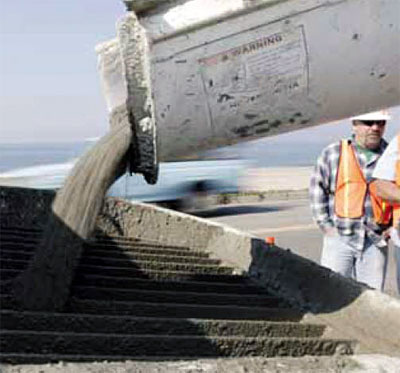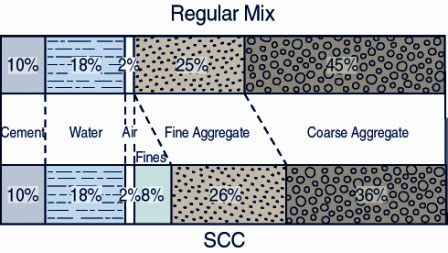Mix Design
 SCC looks very different from conventional concrete while mixing. Concrete producers must “retrain their eyes” for this very fluid mixture as it turns corners and fills forms. Traditionally, concrete with the fluidity of SCC has had a very high water-to-cement ratio, which would lower compressive strengths and compromise durability. Properly designed SCC can save time and labor without sacrificing performance.
SCC looks very different from conventional concrete while mixing. Concrete producers must “retrain their eyes” for this very fluid mixture as it turns corners and fills forms. Traditionally, concrete with the fluidity of SCC has had a very high water-to-cement ratio, which would lower compressive strengths and compromise durability. Properly designed SCC can save time and labor without sacrificing performance.
Two important properties specific to SCC in its plastic state are its flowability and stability. The high flowability of SCC is generally attained by using high-range water-reducing (HRWR) admixtures and not by adding extra mixing water. The stability or resistance to segregation of the plastic concrete mixture is attained by increasing the total quantity of fines in the concrete and/or by using admixtures that modify the viscosity of the mixture. Increased fines contents can be achieved by increasing the content of cementititious materials or by incorporating mineral fines.
Admixtures that affect the viscosity of the mixture are especially helpful when the grading of available aggregate sources cannot be optimized for cohesive mixtures or with large source variations. A well distributed aggregate grading helps achieve SCC with reduced cementitious materials content and/or reduced admixture dosage. While SCC mixtures have been successfully produced with 1 ½ inch (38 mm) aggregate, it is easier to design and control with smaller-sized aggregate. Control of aggregate moisture content is also critical to producing a good mixture. SCC mixtures typically have a higher paste volume, less coarse aggregate, and higher sand-to-coarse aggregate ratio than typical concrete mixtures.
SCC mixtures can be designed to provide the required hardened concrete properties for an application, similar to regular concrete. If the SCC mixture is designed to have a higher paste content or fines compared to conventional concrete, an increase in shrinkage may occur.

SCC: A high-performance concrete innovation.
SCC's flowability is generally achieved by using polycarboxylate-based high-range water-reducing (HRWR) admixtures and optimized concrete ingredients while maintaining a low mixing water content in the concrete. SCC's stability, or resistance to segregation of the plastic concrete mixture, is achieved by using mineral fillers or fines and/or by using viscosity modifying admixtures.


